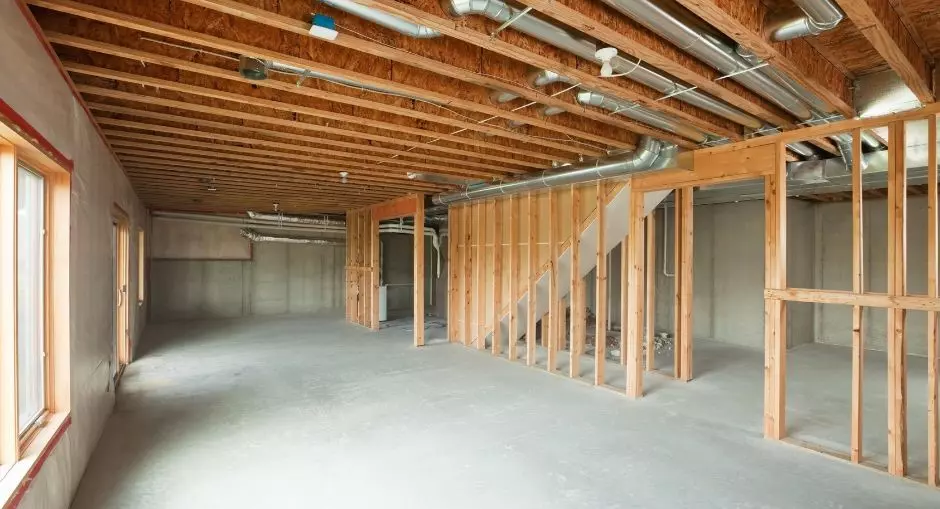How to Finish an Unfinished Basement: A Step-by-Step Guide

How to Finish an Unfinished Basement: A Step-by-Step Guide
I. Introduction
Importance of Finishing a Basement
Transforming an unfinished basement into a fully functional living space is one of the most effective ways to increase your home’s value and livable square footage. Whether you're planning to create a guest suite, a home office, or an entertainment area, finishing your basement can significantly enhance the versatility and functionality of your home. This additional space not only meets your current needs but also offers flexibility for future uses, making it a smart investment.
Overview of the Process
The process of finishing a basement involves several key steps. It begins with planning and preparation, where you'll assess the space, set a budget, and obtain necessary permits. Next, you'll address any challenges such as waterproofing, insulation, and low ceilings. The design phase follows, where you'll choose layouts, flooring, and finishes. Finally, the construction phase brings your vision to life, with framing, electrical work, and finishing touches. By following this step-by-step approach, you can turn your basement into a valuable and inviting extension of your home.
Key Takeaways
- Increase Home Value and Space: Finishing your basement adds livable square footage, boosts home value, and offers versatile space for various uses, such as a guest suite, home office, or entertainment area.
- Comprehensive Planning is Crucial: Begin with assessing the basement for moisture issues and structural integrity. Set a realistic budget, determine the purpose of the space, and obtain necessary permits to ensure everything meets local building codes.
- Address Common Basement Challenges: Effective waterproofing and insulation are essential to prevent moisture problems. Consider solutions for low ceilings and limited natural light, such as recessed lighting and egress windows. Properly manage plumbing and electrical work to ensure safety and functionality.
- Design for Functionality and Aesthetics: Create a layout that suits your needs, choose appropriate flooring, and finish walls and ceilings to match the desired aesthetic. Incorporate lighting and ventilation to maintain a comfortable and welcoming environment.
- Follow a Structured Construction Process: The construction phase includes framing, insulating, installing electrical and plumbing systems, hanging drywall, installing flooring, and completing the space with paint and decorative details.
- Final Inspection and Personalization: Conduct a thorough inspection to ensure all work meets safety standards. Decorate and furnish the space to reflect its intended use, adding personal touches to make it a cozy and functional part of your home.
- Start Your Basement Project: While finishing a basement requires careful planning and execution, the rewards of added space, increased home value, and enhanced functionality make it a worthwhile investment.
II. Planning and Preparation
Assessing the Basement
Before beginning any renovation, it’s crucial to assess the condition of your unfinished basement. Start by checking for moisture issues, such as leaks or mold, which can lead to significant problems if not addressed. Evaluating the structural integrity of the basement is equally important. Look for foundation cracks or other signs of damage that might compromise the safety and longevity of your project.
Determining the Purpose of the Space
Once the basement is deemed structurally sound, consider how you want to use the space. Will it become a cozy guest room, a functional home office, a lively entertainment area, or a dedicated gym? Identifying the primary purpose will guide your design choices and help you create a space that meets your needs.
Setting a Budget
With a clear vision in mind, the next step is setting a budget. Estimate the costs for materials, labor, and any necessary permits. A well-planned budget helps you manage expenses and avoid overspending.
- Obtaining Permits and Meeting Building Codes
Lastly, ensure you understand local regulations by obtaining the required permits. Adhering to building codes is essential for safety and legality, and inspections will help confirm that all work is up to standard.
III. Addressing Basement Challenges
Waterproofing and Insulation
Handling moisture is one of the largest obstacles to finishing a basement. Effective waterproofing is essential to prevent water damage and maintain a dry, comfortable environment. Installing a sump pump, vapor barrier, and proper drainage systems can protect your basement from flooding and dampness. Insulation is another critical factor. Using the right type of insulation, such as rigid foam or spray foam, helps regulate temperature and prevents condensation, ensuring a comfortable living space year-round.
Managing Low Ceilings and Limited Natural Light
Basements often have low ceilings and limited natural light, but these challenges can be addressed with thoughtful design. To increase ceiling height, consider options like lowering the floor or using recessed lighting. Enhancing natural light is also possible by installing egress windows or light wells. These additions not only brighten the space but also improve safety by providing emergency exits.
Handling Plumbing and Electrical Work
Properly managing plumbing and electrical work is crucial for a functional basement. When adding bathrooms or kitchens, strategically position plumbing to minimize costs. Similarly, installing or upgrading electrical systems ensures safety and convenience. This includes adding outlets, lighting fixtures, and circuit breakers designed to handle the new demands of your finished basement.
IV. Designing the Space
Layout and Floor Plan
When designing your finished basement, creating a functional layout is key. Consider whether you prefer an open concept, which provides a spacious, flowing feel, or divided spaces that offer distinct areas for different activities. Also, plan for storage solutions that maximize the utility of your basement, such as built-in shelving or hidden storage under stairs.
Choosing Flooring Options
Selecting the right flooring is crucial for both comfort and durability. Carpeting offers warmth and softness but may be prone to moisture issues in basements. Vinyl is a popular choice due to its water resistance and ease of maintenance, while tile provides a durable and stylish option, though it can feel cold underfoot. Each material has its pros and cons, so choose based on your specific needs and the basement’s conditions.
Wall and Ceiling Finishes
The walls and ceilings of your basement can greatly influence the overall aesthetic. Drywall is a versatile and cost-effective choice for walls, while paneling can add texture and warmth. For ceilings, options like a drop ceiling provide easy access to pipes and wiring, whereas exposed beams offer a more industrial, loft-like vibe.
Lighting and Ventilation
Proper lighting and ventilation are essential for a welcoming basement. Recessed lighting is a popular choice for basements due to its space-saving design, while track lighting can highlight specific areas or features. Ensuring proper ventilation is also important to prevent moisture buildup and maintain air quality, making your basement a healthy and comfortable space.
V. Construction Phase
Framing and Insulating the Walls
The construction phase of finishing a basement begins with framing the walls. This involves building a wooden framework to define the layout of your space. After framing, the next step is insulating the walls to ensure energy efficiency and comfort. Insulation, such as fiberglass batts or spray foam, is installed between the studs to create a barrier against temperature fluctuations and moisture.
Installing Electrical and Plumbing Systems
Once the walls are framed and insulated, it's time to install electrical and plumbing systems. This includes running wiring through the walls, installing outlets, and setting up light fixtures according to your layout. For spaces that include a bathroom or kitchen, plumbing fixtures must be positioned and connected to the main water supply and drainage systems. Proper installation is crucial to meet building codes and ensure the safety and functionality of your basement.
Hanging Drywall and Installing Flooring
With the utilities in place, hanging drywall is the next step. Secure the drywall to the framed walls, then tape and finish the seams for a smooth surface. After the walls are finished, install your chosen flooring material, whether it’s carpet, vinyl, or tile. Proper installation ensures durability and adds the final touch to the room's foundation.
Painting and Final Touches
The construction phase concludes with painting and adding finishing details. Select paint colors that complement the intended use of the space, and apply a finish that suits the environment, such as satin or semi-gloss. Finally, add trim, molding, and other decorative elements to give your basement a polished, complete look.
VII. Conclusion
Recap of the Process
Finishing an unfinished basement is a rewarding project that can significantly enhance your home’s value and functionality. The process involves several key steps, starting with thorough planning and preparation, including assessing the space, setting a budget, and obtaining necessary permits. Addressing challenges such as waterproofing, insulation, and managing low ceilings is crucial to ensure a safe and comfortable environment. The construction phase involves framing, installing electrical and plumbing systems, hanging drywall, and laying down flooring. Finally, the project concludes with painting, decorating, and adding finishing touches, followed by a final inspection to ensure everything meets safety standards.
Encouragement to Start the Project
Taking on a basement finishing project might seem daunting, but with careful planning and attention to detail, it can be a highly rewarding endeavor. Whether you’re looking to create additional living space, a home office, or a recreational area, the possibilities are endless. By transforming your basement, you not only increase your home’s livable space but also add value and versatility. So, why wait? Start planning your basement renovation today and turn that unfinished space into a functional and inviting part of your home. The end product will make the work worthwhile!
Categories
Recent Posts










